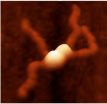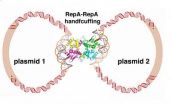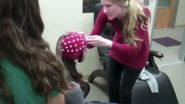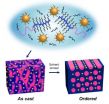(Press-News.org) DURHAM, N.C. -- Staph infections that become resistant to multiple antibiotics don't happen because the bacteria themselves adapt to the drugs, but because of a kind of genetic parasite they carry called a plasmid that helps its host survive the antibiotics.
Plasmids are rings of bare DNA containing a handful of genes that are essentially freeloaders, borrowing most of what they need to live from their bacterial host. The plasmids copy themselves and go along for the ride when the bacteria divide to copy themselves.
A team from Duke and the University of Sydney in Australia has solved the structure of a key protein that drives DNA copying in the plasmids that make staphylococcus bacteria antibiotic-resistant. Knowing how this protein works may now help researchers devise new ways to stop the plasmids from spreading antibiotic resistance in staph by preventing the plasmids from copying themselves.
"If plasmids can't replicate, they go away," said lead author Maria Schumacher, an associate professor of biochemistry in the Duke University School of Medicine. "This is a fantastic new target for antibiotics."
The work appears the week of June 9 in the Proceedings of the National Academy of Sciences.
An essential part of biology, plasmids are so minimalistic they're not even considered alive by themselves. But they're good at ferrying genes from one kind of bacteria to another in a process called horizontal gene transfer. They also excel at adapting to environmental conditions more quickly than their bacterial hosts. Plasmids are able to develop new defenses to an antibiotic and then share that new trick with other bacteria.
Through several years of laborious structural biology to figure out the specific shapes of the molecules involved, the research team has mapped out the structure and function of a protein called RepA, which is crucial to the plasmids' ability to copy its DNA and make a new plasmid.
RepA is a protein that sticks to the beginning of the plasmid's DNA sequence and starts the copying process. "This protein is essential to everything," Schumacher said. "If you don't have it, the plasmid will quickly cease to exist."
Plasmids also need a mechanism to prevent themselves from making too many copies, which would strangle their bacterial host. The researchers have found that RepA is crucial to that function as well.
RepA naturally sticks together in pairs. When a pair of RepA proteins bumps into another pair, as when the cell is starting to get crowded with plasmids, the two pairs of RepA preferentially stick to each other. They form a complex back-to-back, with both having their DNA-grabbing parts facing outward.
When RepA forms this four-part molecule, the plasmids are said to be 'handcuffed,' because two rings of DNA are captured with the locked-up and non-functional RepA complex in the middle.
Once it is handcuffed like this, the plasmid will no longer replicate. Schumacher said this mechanism is apparently how RepA prevents the plasmids from overpopulating the bacterial cell.
Schumacher says RepA is ubiquitous in the plasmid world and doesn't bear much resemblance to other proteins, or to human proteins, making it an attractive drug target. She is hopeful the molecule could be a new site to attack with antibiotics.
"This has been a fun project because we saw many things we didn't expect to see," Schumacher said.
INFORMATION:
The research was supported by the National Institutes of Health and Department of Energy in the U.S., and the National Health and Medical Research Council of Australia.
CITATION: "Mechanism of staphylococcal multiresistance plasmid replication origin assembly by the RepA protein," Maria Schumacher, Nam K. Tonthat, Stephen M. Kwon, Nagababu Chinnam, Michael A. Liu, Ronald A. Skurray and Neville Firth. Proceedings of the National Academy of Sciences, June 9, 2014. DOI: 10.1073/pnas.1406065111
Protein could put antibiotic-resistant bugs in handcuffs
Ubiquitous protein controls copying of resistant DNA
2014-06-09
ELSE PRESS RELEASES FROM THIS DATE:
Parent and child must get enough sleep to protect against child obesity
2014-06-09
URBANA, Ill. – Is sleep one of your most important family values? A new University of Illinois study suggests that it should be, reporting that more parental sleep is related to more child sleep, which is related to decreased child obesity.
"Parents should make being well rested a family value and a priority. Sleep routines in a family affect all the members of the household, not just children; we know that parents won't get a good night's sleep unless and until their preschool children are sleeping," said Barbara H. Fiese, director of the U of I's Family Resiliency Center ...
Land quality and deforestation in Mato Grosso, Brazil
2014-06-09
PROVIDENCE, R.I. [Brown University] — The state of Mato Grosso is the epicenter of an agricultural revolution in Brazil. During the last 15 years, expansion of agriculture in the state has helped Brazil become one of the world's top producers of soy, corn, cotton, and other staple crops. Despite the increase in production, the rate at which Amazon forestland in the state was cleared to make room for new farmland slowed significantly in the second half of the last decade.
Much of the credit for slowing deforestation has been given to government policies and intervention, ...
Does 'free will' stem from brain noise?
2014-06-09
VIDEO:
UC Davis researchers found that the pattern of electrical activity in the brain immediately before making a decision can predict the choice made. This video shows how these experiments are...
Click here for more information.
Our ability to make choices — and sometimes mistakes — might arise from random fluctuations in the brain's background electrical noise, according to a recent study from the Center for Mind and Brain at the University of California, Davis.
"How ...
Humanitarian liking on Facebook
2014-06-09
"Liking" a page on the social networking site Facebook is a new form of civic engagement and humanitarian support, so concludes research published in the International Journal of Web Based Communities. According to the paper's authors social motives and an emotional response underpinned users' inclination to like, or follow, a page, rather than their simply seeking information and news.
Petter Bae Brandtzaeg and Ida Maria Haugstveit of Scandinavian research organization SINTEF in Oslo, Norway, surveyed more than 400 Facebook users about their habits on the site and their ...
Berkeley Lab researchers create nanoparticle thin films that self-assemble in 1 minute
2014-06-09
The days of self-assembling nanoparticles taking hours to form a film over a microscopic-sized wafer are over. Researchers with the U.S. Department of Energy (DOE)'s Lawrence Berkeley National Laboratory (Berkeley Lab) have devised a technique whereby self-assembling nanoparticle arrays can form a highly ordered thin film over macroscopic distances in one minute.
Ting Xu, a polymer scientist with Berkeley Lab's Materials Sciences Division, led a study in which supramolecules based on block copolymers were combined with gold nanoparticles to create nanocomposites that ...
'Hello, world!' NASA beams video from space station via laser
2014-06-09
"Hello, World!" came the message from the International Space Station as NASA successfully beamed high-definition video via laser from space to ground on Thursday, June 5. The 175-megabit video transmission was the first of its kind for the Optical Payload for Lasercomm Science (OPALS) with the goal of improving the way we receive data from orbit and beyond. In fact, this emerging technology of optical communications--or lasercomm--is likened to an upgrade from dial-up to DSL.
"It's incredible to see this magnificent beam of light arriving from our tiny payload on the ...
African-American women more likely to be diagnosed with higher risk breast cancer
2014-06-09
Washington, D.C., June 9, 2014 - A research study led by cancer specialists at MedStar Washington Hospital Center found that African-American women frequently present with biologically less favorable subtypes of breast cancer.
Researchers at the Hospital Center's Washington Cancer Institute analyzed the biology of breast cancer in 100 African-American women, using a method of genomic profiling. These genomic tests look at the expression of genes associated with the risk of recurrence in the population and further characterizes the biology of the tumor. The 70-gene MammaPrint ...
Affordable housing linked to children's test scores
2014-06-09
It's long been accepted – with little science to back it up – that people should spend roughly a third of their income on housing. As it turns out, that may be about how much a low-income family should spend to optimize children's brainpower.
Johns Hopkins University researchers have explored the effects of affordable housing on the cognitive development, physical health, and emotional wellbeing of children living in poverty. How much a family spends on housing has no impact on a child's physical or social health, they found, but when it came to cognitive ability, it ...
New study finds text messaging program benefits pregnant women
2014-06-09
WASHINGTON, DC (June 9, 2014) – The leading mobile health service in the nation, Text4baby, was found to significantly benefit pregnant women, according to a new study led by Milken Institute School of Public Health (Milken Institute SPH) at the George Washington University and the Madigan Army Medical Center. The pilot study examined several things including the short-term effects of Text4baby exposure four weeks post enrollment on attitudes, beliefs and behaviors targeted by the text messages.
"This study provides the strongest evidence to date that Text4baby reduces ...
Combined MMRV vaccine shows slight rise in adverse events
2014-06-09
The combined measles–mumps–rubella–varicella (MMRV) vaccine shows a slightly increased risk of febrile seizures in children, compared with the previously separate vaccines for MMR and varicella (chickenpox) (MMR+V), according to an article in CMAJ (Canadian Medical Association Journal).
The MMRV vaccine was developed for young children to reduce the number of needles they receive. However, the combined vaccine has been associated with slightly higher rates of febrile seizures.
Febrile seizures can accompany high fever in young children; although distressing, they are ...
LAST 30 PRESS RELEASES:
Fame itself may be critical factor in shortening singers’ lives
Daily coffee drinking may slow biological ageing of people with major mental illness
New highly efficient material turns motion into power – without toxic lead
The DEVILS in the details: New research reveals how the cosmic landscape impacts the galaxy lifecycle
After nearly 100 years, scientists may have detected dark matter
Gender imbalance hinders equitable environmental governance, say UN scientists
Six University of Tennessee faculty among world’s most highly cited researchers
A type of immune cell could hold a key to preventing scar tissue buildup in wounds
Mountains as water towers: New research highlights warming differences between high and low elevations
University of Tennessee secures $1 million NSF grant to build semiconductor workforce pipeline
Biochar shows powerful potential to build cleaner and more sustainable cities worldwide
UT Health San Antonio leads $4 million study on glucagon hormone’s role in diabetes, obesity
65-year-old framework challenged by modern research
AI tool helps visually impaired users ‘feel’ where objects are in real time
Collaborating minds think alike, processing information in similar ways in a shared task
Routine first trimester ultrasounds lead to earlier detection of fetal anomalies
Royal recognition for university’s dementia work
It’s a bird, it’s a drone, it’s both: AI tech monitors turkey behavior
Bormioli Luigi renews LionGlass deal with Penn State after successful trial run
Are developers prepared to control super-intelligent AI?
A step toward practical photonic quantum neural networks
Study identifies target for disease hyper progression after immunotherapy in kidney cancer
Concordia researchers identify key marker linking coronary artery disease to cognitive decline
HER2-targeted therapy shows promising results in rare bile duct cancers
Metabolic roots of memory loss
Clinical outcomes and in-hospital mortality rate following heart valve replacements at a tertiary-care hospital
Too sick to socialize: How the brain and immune system promote staying in bed
Seal milk more refined than breast milk
Veterans with cardiometabolic conditions face significant risk of dying during extreme heat events
How plants search for nutrients
[Press-News.org] Protein could put antibiotic-resistant bugs in handcuffsUbiquitous protein controls copying of resistant DNA






